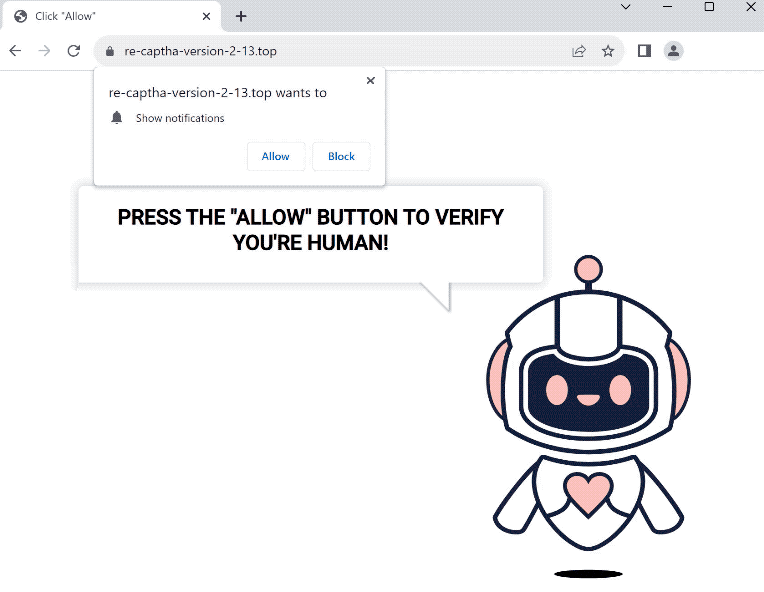re-captha-version is a highly questionable website that tries to trick users into allowing ads on the desktop. It misuses a legitimate browser feature to do this, which is why you will immediately get a browser alert saying “re-captha-version-2-13.top wants to show notifications” upon entering the site. If you click “Allow”, you will authorize the site to spam you with ads. Fortunately, this permission is easily revoked.
The site will prompt your browser to show a browser alert saying “re-captha-version wants to show notifications”. While this is a legitimate feature, it’s often misused by questionable sites. If you click “Allow”, the site will be able to spam ads on your desktop. These ads may resemble legitimate system notifications and appear in a similar place. This can get confusing for users, and they may be tricked into interacting with them. The ads could expose users to potentially dangerous content, including scams and malicious threats.
In case you have given re-captha-version permission to show you notifications, you can easily revoke it in your browser’s settings. Instructions can be found at the end of this report.
Why are you redirected to sites like re-captha-version?
You can be redirected to sites like re-captha-version for a couple of reasons. In rare cases, redirects are a symptom of adware. But most commonly, users are redirected when browsing high-risk websites. Certain sites expose users to a lot of advertisement content. Sites that have pirated or pornographic content are particularly guilty of this. Clicking on anything on those sites will often trigger a redirect. However, both ads and redirects are easily blockable with a good adblocker program.
Redirects to re-captha-version can also be a symptom of an adware infection. These types of infections are installed accidentally by users via the free software bundling method. Adware infections can be added to popular free programs as additional offers. These offers are set to be installed alongside the programs they’re attached to automatically. Users’ explicit permission is not required.
Additional offers are technically optional but they need to be manually deselected to prevent their installations. In most cases, users do not notice these added offers because they are hidden in settings they don’t normally use. This makes software bundling quite a controversial installation method.
These offers are always optional, so if you pay attention when installing free programs, you will be able to prevent these unwanted installations. During installation, choose Advanced (Custom) settings instead of Default (Basic). The installation window recommends using Default settings but if you do that, all added offers will be authorized to install alongside without your explicit permission. Advanced or Custom settings clearly display all added offers. Those settings will also allow you to deselect everything that has been added. It’s never a good idea to install added offers, even if they initially appear useful.
Legitimate programs do not use software bundling to install, and those that do are often detected as potential threats by anti-virus programs. If you are not careful when installing free programs, you will fill your computer with junk like adware.
How to stop re-captha-version notifications?
We strongly recommend scanning your computer with an anti-virus program to check for an adware infection. Adware can be tricky to remove manually so using an anti-virus program is easiest. If you want to block future redirects and random ads, install a good adblocker program.
In case you have given re-captha-version permission to show you notifications, you can revoke the permission in your browser’s settings. This is not difficult to do but you can use the instructions provided below. Review all sites that have permission to show notifications and remove re-captha-version and all others you do not recognize. If you don’t intend to use this feature, you can also turn off the notification requests altogether.
If you have given the site permission to show notifications, here’s how to revoke it:
- Mozilla Firefox: Open the menu (the three bars at the top-right corner), click Options, then Privacy & Security. Scroll down to Permissions, press Settings next to Notifications, and remove re-captha-version and any other questionable websites from the list. It’s possible to permanently turn off push notification requests by checking the “Block new requests asking to allow notifications” box in the same Notifications settings.
- Google Chrome: Open the menu (the three dots top-right corner), then Settings, then Privacy and security, then Site Settings. Click on Notifications under Permissions, and remove re-captha-version and any other questionable websites from the list. It’s possible to permanently turn off push notification requests by toggling off “Sites can ask to send notifications”.
- Microsoft Edge: Open the menu (the three dots top-right corner), then Settings, then Cookies and site permissions, then Notifications. Review which sites have permission and remove re-captha-version and any other questionable websites from the list. It’s possible to permanently turn off push notification requests by toggling off “Ask before sending”.
Site Disclaimer
2-remove-virus.com is not sponsored, owned, affiliated, or linked to malware developers or distributors that are referenced in this article. The article does not promote or endorse any type of malware. We aim at providing useful information that will help computer users to detect and eliminate the unwanted malicious programs from their computers. This can be done manually by following the instructions presented in the article or automatically by implementing the suggested anti-malware tools.
The article is only meant to be used for educational purposes. If you follow the instructions given in the article, you agree to be contracted by the disclaimer. We do not guarantee that the artcile will present you with a solution that removes the malign threats completely. Malware changes constantly, which is why, in some cases, it may be difficult to clean the computer fully by using only the manual removal instructions.
